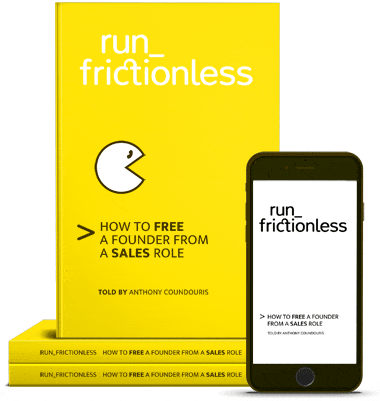
Grow your marketing agency faster with the 4Qs
>
Grow your marketing agency faster with the 4Qs
It is essential you grow your agency 🙌 to keep up with attrition. Agencies lose business when customers or staff leave. The work delivered by agencies is often project-based. Once the project is over, the work dries up until the customer starts a new project.
In January 2020, we began working with several 👍 creative agencies. These firms applied the 4Qs framework in an effort to reduce friction and improve their odds of creating a customer. Advertising agencies, event marketing companies, branding houses, and design shops can benefit from the 4Qs decision-making framework.
It is not easy to grow your agency. You face an immense amount of friction. After discussions with agency-owners, we identified a few common friction points:
There are a few ways you can grow your agency and overcome these friction points, by applying the 4Qs framework.
Customers cannot afford our fees
During the first few meetings between an agency and its client, a game of cat and mouse is in play. The agency is trying to discern if the client can afford their fee and the client is trying to discern how cheap they can secure the agency’s services.
Understanding whether a customer has the liquidity to buy services is essential. Agencies frequently spend time on customers who have 👎 no intention of buying. After months of courtship, they discover the customer is prepared to pay a fraction of what the agency quoted.
You want to discover the budget as quickly as possible. However, you want to avoid adding friction in the process. The following are a set of measures designed to counter this kind of friction.
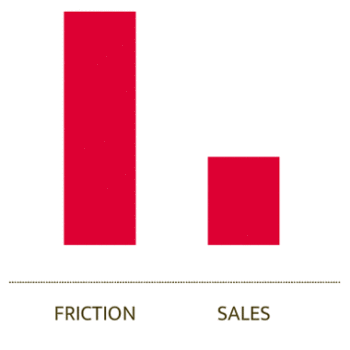
SEND A QUOTE AS QUICKLY AS POSSIBLE
The quotation is one interaction that uncovers whether a customer can or cannot afford an agency’s services. This interaction forces the customer to reveal their hand and show the budget.
When designing the customer flow in Quadrant 4, design an expedient experience leading up to the quote.
If it takes you three weeks and eight interactions before your agency can furnish a customer with a quote, try to get the job done is one week with three interactions.
The more frictionless 🙌 you make the process, the less time and money is expended serving fake customers 😂.
Even if the quote is an estimate only, it will give your agency a read on how likely the customer will buy. Preface the quote as an ‘estimate’. This will give you the scope to revise the price when more information comes to light.
Getting the customer a quote quickly demonstrates your agency is trustworthy. Expect many of your competitors to hold back the quote and wait for the customer to reveal more information.

DOWN-SELL BEFORE YOU UPSELL
It can cost three times more to win a new client compared to selling services to an existing client. Create a customer at the lowest possible cost, and upsell later.
The burger 🍔 giant Macdonald’s educated business graduates for decades to upsell 💪 customers by asking “would you like fries with that”? Unfortunately, what they didn’t teach was upsell is a tactic that works when an organization has a track record with their customer. Instead, when dealing with a first-time customer, successful agencies down-sell.
Design and pitch a product from Quadrant 2 with a small ticket price that is well below a customer’s expected average budget. This eliminates friction by making the budget irrelevant. This measure works by reducing the risk for a customer to try the agency services at the lowest possible cost. Once the agency proves they can deliver and can be trusted, they can take aim at a larger project.
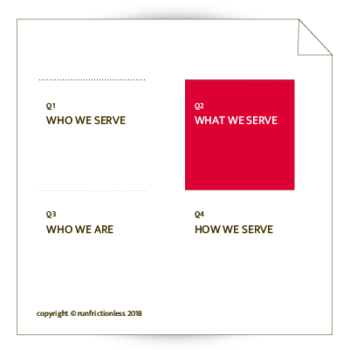
TURN THE QUESTION OF BUDGET INTO A VALUE PROPOSITION
If you would like the customer to reveal their budget, present a reason why it is in their interest to share the figure. Customers are not stupid. They are aware of when they are being profiled and sized up 🤔 by agency account managers. They know agencies practice price discrimination, often raising or drastically cutting fees to win business.
Here is a value proposition which makes it easier for your customers to show their hand. Cut and paste ✂️ this sentence into your next email.
DISCOVER THE BUDGET WITHOUT ASKING
Some customers won’t tell you their budget. Any effort to raise the subject is met with indifference or hostility.
Thankfully, I have another technique to share to help you overcome this friction point.
How much do you know about data points and customer profiling? A big part of Quadrant 1 is deciding whom you serve. This involves identifying customer profiles according to a variety of data points. The kinds of data points I suggest you investigate may be unrelated to the question of budget. For example, you may decide a data point ☝ is whether the customer has appointed a Chief Content Officer. You infer if they have such a person, the company has a level of sophistication required to use your services. You infer if they have such a person, the company has a level of sophistication required to use your services.
Another data point is whether they spend money on office fit-outs and retail stores. You infer if they spend no money on these assets, they cannot afford your fees.
So, you see, there is profit in profiling customers. I’ve blueprinted a small business customer profile you can download and use.
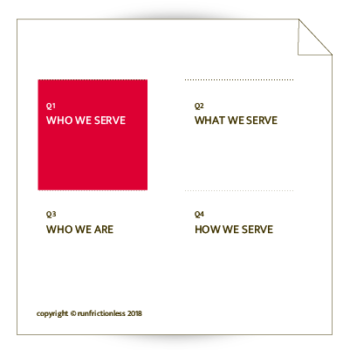
Customers ask for free stuff, and we give it to them
Free is not a bad thing in itself. Many businesses, particularly internet startups offer a freemium to customers. It is one way to reduce the risk for a customer to try before they buy.
The problem is agencies are notoriously slack 😖 at defining their free and paid services. Customers, sensing the ambiguity, hack the agency by demanding more and more free stuff.
Internet startups have an excellent track record 👏 of defining their freemiums in explicit terms. For example, a 14-day free trial expires after 14-days of use. In rare cases, freemiums can be free forever, meaning there is no time limit. Or the freemium places a limit over the features available.
Agencies often make the mistake of offering free services, but not defining exactly what free means. Successful agencies write product factsheets (found in Quadrant 2) will give your staff and customer clear expectations on what is free and paid. An example of a product factsheet for a consulting company can be found here.
The factsheet spells out the features but also names the limit and what part of the product is free.
Earlier I mentioned how agency owners could create a low-cost product to create a customer at the lowest possible cost. In conjunction, offer to discount the value of the bigger product, if they buy the smaller product today. For example, if the small product is worth 10 bucks and the big product is worth 100 dollars, offer to discount the big product by 10 dollars if they buy the little one. This makes the small product perceived as free even though the customer paid.
We make no profit serving small business owners
Agency owners complain the time taken to serve a small business owner is the same as the time taken to serve an enterprise decision-maker. The difference is small business owners pay a fraction of what the enterprise customer will pay. The result is either the agency will:
Here are some measures successful agencies can take to overcome this friction.
DECIDE NOT TO SERVE SMALL BUSINESS OWNERS
It is better to refuse this profile entry to your agency than serve them and risk receiving negative reviews 👎 and lower profits.
Notice I call the customer profile a small business owner and not a small business. That’s because there is no such profile as an SME. Only people buy. What’s more, deciding who you serve is as important as deciding who you serve. You are not obliged to serve every person who arrives on your doorstep.
If you make this your goal, it becomes easy to focus on customers who need you most and refuse those you don’t serve to another agency.
In a moment I’ll share more reasons why agency owners should not serve every customer profile. However, if you insist on serving small business owners, I have some ideas to share.
GET A GOOD QUADRANT 1-2 FIT
Think deeply about Quadrant 1. Thin slice the small business owner into several variants and look for a variant to you can add value. Then from Quadrant 2, design a product with fewer features that solves 👍 a specific problem small business owners face.
Match Quadrant 1 as close to Quadrant 2 as you can. The product you develop will look very different to the one you serve to an enterprise. Your new product should be singular and perhaps delivered by content or software, not humans.
Be on the lookout for a product you can white label and wrap with your agency’s brand. A white-labeled product is off-the-shelf and will cut down development time.
If you have a well-organized account manager who has a grip on Quadrant 1, encourage them to build new products and carry some of the workload from Quadrant 2. Incentivize them to do so by profit sharing on those said products.
Got a good Quadrant 1-2 fit? Okay, it’s time to upgrade Quadrant 4.
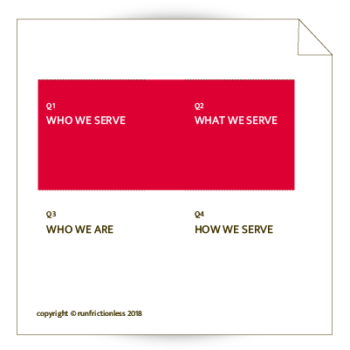
GET A GOOD QUADRANT 1-4 FIT
Quadrant 4 addresses what it feels like to become a customer of your agency. It is the precise number of interactions required to make a customer. In short, this quadrant can be thought of as the customer journey, map or flow.
A customer journey for small business owners differs from enterprise decision-makers. That means each time you define a new customer profile from Quadrant 1, you need to fit a new experience from Quadrant 4. Hence, achieve a Quadrant 1-4 fit.
I suggest you design a low-touch flow for small business owners with fewer interactions and semi-automation. We found you can create an enterprise customer in 25-50 interactions. However, you will need far fewer for a small business owner, around 10-15 interactions only. This is one of the reasons small business owners make ✌ great customers. Your cost to serve can be less because you manage fewer interactions.
However, it is unlikely you can port any interactions from enterprise flow to your small business flow. Sorry about that! Except for perhaps prequalification, the specific interactions for enterprise will be different from small business owners.
I have blueprinted a customer journey for a small business owner here:
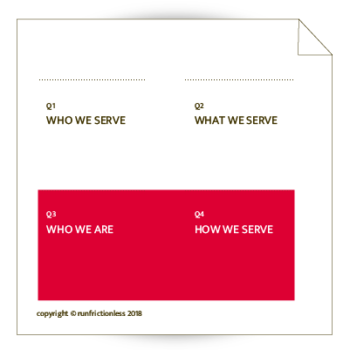
We face resource constraints
A factor preventing agency growth is production constraints. Agencies, like other consulting firms that provide human services, reach a limit on how much work they can output. I can think of a few ways to navigate this friction point.
DEFINE WHO YOU SERVE TODAY
Turn the situation to your advantage. Name the product limit in Quadrant 2, and use the limit to force a buying decision or improve the agency’s positioning as a premium player (Quadrant 3). The tone of your communication reads something like:
Instead of your customer choosing you, you chose the customer. Now here comes the answer to your question:
There is no point serving customer profiles, who you know, will never provide a positive review. Some profiles may not appreciate the work you do. The positive reviews and word-of-mouth are what make closing the next sale easier. Here is a second answer to the question:
Restaurants build their products in the kitchen while the customer waits at a table. Agencies build their products in real-time together with the customer, introducing many types of risks. Customers who refuse to collaborate with an agency impact the success of the project, and the customer’s own satisfaction.
In 2005, I ran an agency in Singapore called Firestarter. It was a successful agency, with accounts like Google, SAP, and salesforce.com. The salespeople and I wrote a personality test 🌟 which we ran on first-time customers. If the customer (direct contact) did not pass our psyche test, we didn’t take the project. We encourage customers who didn’t pass to seek services from a competitor.
The test was a simple formula we could apply. The formula took into account the customer’s experience, how well they managed people and the complexity of the project.
NAME LIMITS IN QUADRANT 2
Quadrant 2 is all about the product fact sheet. A product fact sheet names the features and limits of the agency’s product. The customer learns as much about the product through limits as they do reading a list of functions. An agency that takes projects, when there is no spare capacity, is much like a restaurant taking a booking from a customer when there are no more tables available. Both businesses will wind up 🤫 disappointing the customer.
Limits improve a customer’s expectation of what a product does and doesn’t do. Making limits known early manages customer expectations and reduces the chance you will inconvenience a customer.
Whatsmore, when agencies name limits, they can educate the customer on known work-arounds. Customers learn over time what hours of the day the restaurant is likely to be fully booked, and use work-arounds like ordering home delivery or arriving a few hours earlier. Likewise, agencies can educate their clients about how to overcome their capacity limit.
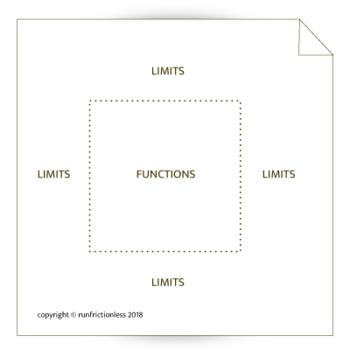
We find it hard to deliver what we promise
When customers engage the services of agencies, one of their fears is the sales pitch delivered by the account manager, will not live up to the product delivered. The fear 😓 is shared. Salespeople fear the trust they have built with a customer will be destroyed the moment they handshake the customer to the production people.
Customers experience friction during a handover for a number of reasons. The salespeople either:
Successful agencies bridge the gap between sales and production, so the experience for the customer is seamless. Here are a few methods.
BLUEPRINT THE PRODUCTION EXPERIENCE
Extend the customer’s journeys in Quadrant 4, deeper into the organization. Blueprint each interaction that occurs after the handshake. If the production people are busy, a customer map and instructions on when and what to send the customer is invaluable. The salespeople will be more confident and accurate when making promises on when the customer can expect milestones to be delivered.
CREATE SUCCESS MANAGERS
This third organization sits between the salespeople and delivery. Instead of the salespeople trying to project manage delivery, the success managers are responsible for delivering what was sold.
I have seen this work in very large organizations, though it is not always an experience that is embraced by customers. Each time new people are introduced into the relationship, there is a risk the customer will drop-off.
MAKE CUSTOMER SUCCESS A SALES KPI
Make customer success a KPI of the salespeople. I prefer this approach. Often a sale falls apart later because of the way the relationship began. Instead of gathering intelligence on the customer’s context and needs, the salespeople focus on closing the deal.
What unfolds is a situation where the organization discovers the customer twice. Once when the salesperson makes contact and again when they are handed to production.
This situation could be avoided if salespeople gather intel during the early and middle game. The intel forms the basis of a brief that helps the production team add value.
OFFER A MONEY-BACK GUARANTEE
Nothing helps accelerate agency growth faster than a 30 or 60-day money-back guarantee. Successful agencies are so confident in their service, they can offer to insure the customer. In the short term, this measure punishes the company financially. However, long term, it’s a business builder because it forces the salespeople and the production people to solve any problems which pop up during the handshake.
I have used this policy in one of my startups and it made a ✊ positive impact. An agency that can protect a customer against failure can charge a premium. It gives customers comfort that staff may not listen, but management will listen. An agency can use the policy in reverse, and squeeze out customers they decide not to serve.
Nothing stops time being wasted on a customer who will not collaborate, than writing them a refund check. I never had a situation where a customer unfairly asked for a refund. Had this situation occurred I would use the intelligence to better define who I do not serve in Quadrant 1.

get started
using the
4Qs
Key takeaways

run frictionless
now for only US$995





